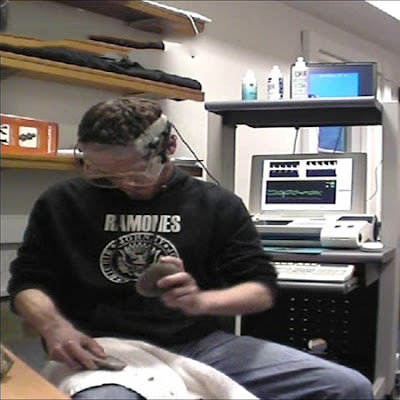Language and tool-making skills evolved at same time
Lo stato della ricerca , presso l'Università di Liverpool porta a concludere che il cervello sfrutta le medesime capacità per il linguaggio e per la costruzione di utensili: pertanto le due capacità umane potrebbero essersi evolute contemporaneamente.
Research by the University of Liverpool has found that the same brain activity is used for language production and making complex tools, supporting the theory that they evolved at the same time.
I ricercatori dell'Università hanno controllato l'attività cerebrale di 10 esperti lavoratori della pietra (scheggiatori) sia mentre producevano un utensile, sia mentre affrontavano un test del linguaggio.
 |
| Three hand axes produced by participants in the experiment. Front, back and side views are shown [Credit: University of Liverpool] |
Researchers from the University tested the brain activity of 10 expert stone tool makers (flint knappers) as they undertook a stone tool-making task and a standard language test.
Misurato il flusso ematico durante l'attività.
Misurato il flusso ematico durante l'attività.
Brain blood flow activity measured
E' stato misurato il flusso ematico cerebrale dei partecipanti, durante ambedue le attività, usando un ecodoppler grafia funzionale transcranica, che normalmente si impiega per valutare l'eventuale danno cerebrale post traumatico o pre operatorio.
E' stato misurato il flusso ematico cerebrale dei partecipanti, durante ambedue le attività, usando un ecodoppler grafia funzionale transcranica, che normalmente si impiega per valutare l'eventuale danno cerebrale post traumatico o pre operatorio.
They measured the brain blood flow activity of the participants as they performed both tasks using functional Transcranial Doppler Ultrasound (fTCD), commonly used in clinical settings to test patients’ language functions after brain damage or before surgery.
I ricercatori hanno ottenuto pattern cerebrali correlati per ambedue le attività, il che suggerisce che ambedue sfruttano le medesime aree cerebrali. Il linguaggio e la capacità di produrre utensili di forma voluta dalle pietre sono attività considerate caratteristiche esclusivamente umane, che hanno avuto un'evoluzione di milioni di anni.
I ricercatori hanno ottenuto pattern cerebrali correlati per ambedue le attività, il che suggerisce che ambedue sfruttano le medesime aree cerebrali. Il linguaggio e la capacità di produrre utensili di forma voluta dalle pietre sono attività considerate caratteristiche esclusivamente umane, che hanno avuto un'evoluzione di milioni di anni.
The researchers found that brain patterns for both tasks correlated, suggesting that they both use the same area of the brain. Language and stone tool-making are considered to be unique features of humankind that evolved over millions of years.
Darwin fu il primo a suggerire che l'uso di strumenti ed il linguaggio potessero essere andati incontro ad un'evoluzione contemporanea, in quanto entrambe le capacità dipendono da una complessa pianificazione e dalla coordinazione di differenti azioni, ma fino ad oggi non si era data una prova convincente di questa possibilità.
 |
| The brain activity of an experienced flint-knapper is monitored using a Transcranial Doppler Ultrasound, as he works the stone [Credit: University of Liverpool] |
Darwin was the first to suggest that tool-use and language may have co-evolved, because they both depend on complex planning and the coordination of actions but until now there has been little evidence to support this.
Il dottor Georg Meyer, del Dipartimento di psicologia Sperimentale sostiene "Questo è il primo studio sul cervello che metta direttamente a confronto la confezione di manufatti complessi ed il linguaggio".
Il dottor Georg Meyer, del Dipartimento di psicologia Sperimentale sostiene "Questo è il primo studio sul cervello che metta direttamente a confronto la confezione di manufatti complessi ed il linguaggio".
Dr Georg Meyer, from the University Department of Experimental Psychology, said: “This is the first study of the brain to compare complex stone tool-making directly with language.
La manifattura di strumenti ed il linguaggio evolvettero parallelamente.
La manifattura di strumenti ed il linguaggio evolvettero parallelamente.
Tool use and language co-evolved
"Il nostro studio ha correlato i pattern del flusso ematico nei primi 10 secondi dall'inizio del compito, in ambedue le attività. Questo dimostra che ambedue le attività sono dipendenti dalle stesse aree cerebrali ed è coerente con la teoria per cui la costruzione di strumenti complessi di pietra ed il linguaggio si evolvettero contemporaneamente e condividono analoghi percorsi nel cervello".
"Il nostro studio ha correlato i pattern del flusso ematico nei primi 10 secondi dall'inizio del compito, in ambedue le attività. Questo dimostra che ambedue le attività sono dipendenti dalle stesse aree cerebrali ed è coerente con la teoria per cui la costruzione di strumenti complessi di pietra ed il linguaggio si evolvettero contemporaneamente e condividono analoghi percorsi nel cervello".
“Our study found correlated blood-flow patterns in the first 10 seconds of undertaking both tasks. This suggests that both tasks depend on common brain areas and is consistent with theories that tool-use and language co-evolved and share common processing networks in the brain.”
La dott.sa Natalie Uomini del Dipartimento di archeologia (Classics & Egiptology) conferma che nessuno prima aveva misurato l'attività cerebrale mentre il soggetto costruiva uno strumento: si tratta di una prima volta, sia per la psicologia, sia per l'archeologia.
La dott.sa Natalie Uomini del Dipartimento di archeologia (Classics & Egiptology) conferma che nessuno prima aveva misurato l'attività cerebrale mentre il soggetto costruiva uno strumento: si tratta di una prima volta, sia per la psicologia, sia per l'archeologia.
Dr Natalie Uomini from the University’s Department of Archaeology, Classics & Egyptology, said: “Nobody has been able to measure brain activity in real time while making a stone tool. This is a first for both archaeology and psychology.”
I risultati sono pubblicati su PLoS ONE.
I risultati sono pubblicati su PLoS ONE.
Source: University of Liverpool [September 02, 2013]